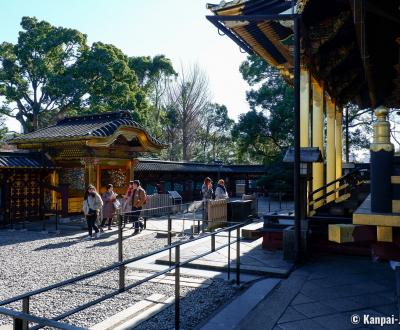Ueno Toshogu
The Tokugawas’ Golden Mausoleum in Tokyo
Ueno Toshogu is a shinto shrine located in Ueno Park, in the north-east of the Japanese capital. It was built in 1627 to honor Tokugawa Ieyasu (1542 - 1616), the pacifier of Japan during Sengoku period and founder of the Tokugawa bakufu (the shogun’s government). The shrine is characterized by alleys lined with lanterns and a profusely gilded main hall.
The name "Tosho-gu" is a reference to Tosho Daigongen, the posthumous title granted to Tokugawa Ieyasu by Japan’s Imperial Power. Several shrines throughout the country bear the same name and are mausoleums to shoguns of Tokugawa lineage. Nikko’s Toshogu is the most famous and larger in size. In the surroundings of Tokyo, Kunozan Toshogu in Shizuoka is also worth a visit for its intimist atmosphere and the beauty of its ornaments; in Saitama prefecture, Shodozan temple is renowned for the detailed wooden sculptures of its façades.
Ueno Toshogu is ideally located in the iconic and very touristic Ueno Koen Park. The shrine’s grounds are surrounded by Ueno Zoo, Shinobazu pond and Gojo Shrine. Close to the main intersections of the park, its entrance is on a secondary alley, not easily noticeable. But the stone torii ⛩️ and a couple of signs help to find the way. There is a secondary entrance from Shinobazu Gate, located on an even more remote alley.
Each side of the path to the shinto pavilions are lined with several rows of stone and copper lanterns 🏮. Those are offerings made by feudal lords when the main hall was rebuilt in 1651 by the third shogun, Tokugawa Iemitsu, to honor of his grandfather. Aside Tokugawa Ieyasu’s, the spirits of Tokugawa Yoshimune (eighth Tokugawa shogun) and Tokugawa Yoshinobu (fifteenth and last shogun of the dynasty) are enshrined at Ueno Toshogu.

An attractive small sacred area
The wonderful Karamon gate marks the entrance to the main and sacred enclosure of Ueno Toshogu. Its originality comes from its golden color and dragon’s carvings, made by Hidari Jingoro, a famous sculptor from Edo period (1603 - 1868). The enclosure is materialized by the refined openwork Sukibei wall, in the same architectural style adorned with lovely animal sculptures. The main pavilion can be seen through the interstices. Its inner rooms are unfortunately not open to the public, but the building nonetheless has a fascinating beauty and aura.
Of gongen zukuri style, the haiden (building for worship) and the honden (main shrine) are sheltered together under an H-shaped roof. Take your time to admire this original structure of black and gold hues. The buildings have withstood the passing of time and especially the great earthquakes that hit the area.

The peonies garden
The Botan-en garden is on the left of the main alley leading to the shrine and displays a beautiful collection of peonies to admire in winter, as well as in spring 🌸.
From early January to mid-February, about two hundreds of species of the Paeoniaceae family, named Fuyu-Botan (meaning "winter peonies") bloom along a pleasurable short walk. The flowers are symbols of good fortune and their beauty has inspired the greatest artists, such as Utagawa Hiroshige (1797 – 1858) who liked drawing them in his etchings.
The flowers’ vivid colors and subtle aroma are particularly enjoyable in winter when the rest of the vegetation is still dormant. The peonies protected from snowfall by straw mats or small Japanese umbrellas, are a pleasant highlight in the visit of Ueno Toshogu.


